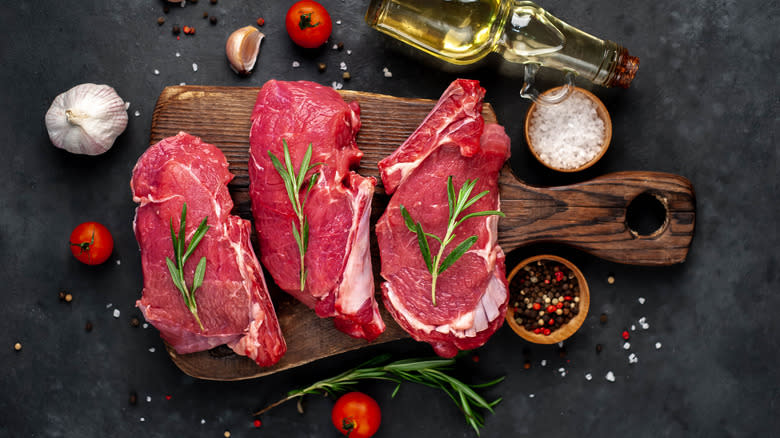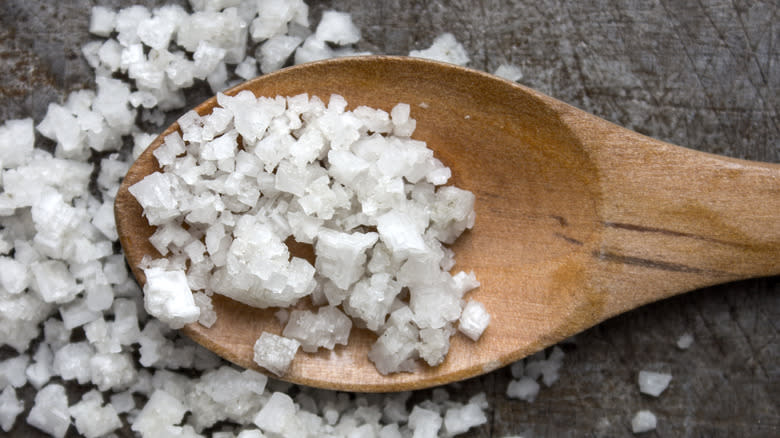The Best Salt Variety To Use In Your Dry Brine

Dry brining meat instead of wet brining has many benefits, and a dry brine can be incredibly useful if you're prepping a Thanksgiving turkey or a special-occasion steak. Dry brining is the secret to perfectly cooked chicken breasts, as it's a process that helps prepare your protein to be flavorful and juicy with the help of a lot of salt, some extra seasonings, and a bit of time.
In a nutshell, dry brining is done by simply covering your raw meat with salt and — sometimes — a seasoning mix. (Specifics depend on the meat and the recipe, but we're here for the salt.) Then, just let it sit in the refrigerator for a while before cooking. The reaction that occurs will help keep the meat moist and flavorful while also breaking down fibers to make even tough cuts more tender. Selecting the suitable salt for the job will make a world of difference when it comes time to serve up the final product.
If you plan on dry brining, ensure you have kosher salt on hand. We'd also argue that a specific shape of kosher salt — specifically, brands with pyramid-shaped grains, like Diamond Crystal — will work better than any other kind of salt on the market.
Read more: 11 Things You Didn't Know You Should Be Doing With Bacon
Coarse Grains Of Kosher Salt Will Make Dry Brining A Breeze

No matter what other variables are in your recipe, salt is the key component of a dry brine. The first step is completely and evenly covering your meat with salt, and here's why kosher salt is the real deal.
Those large, coarse, angular grains of kosher salt will cling to the surface of your meat more efficiently, and it'll be easier to get an even coating. If you tried to do the same thing with table salt, you'd end up making a mess, having grains spill all over the place, and there's probably going to be a lot of clumping going on, too. Try to use your fingers to sprinkle table salt, and you'll get an inconsistent stream instead of even coverage. Table salt also has a heavier salt flavor, and using it to cover the surface of the meat in the way that's necessitated by a dry brine will leave you with an overwhelmingly salty dinner. While table salt is fine for some things, the properties aren't what you want for a dry brine.
It's worth noting, too, that dry brining doesn't involve just sprinkling some salt on top of a steak. Dry brining means getting all the sides, angles, and surfaces, which can be tough with something like chicken. It's easier with pyramid-shaped flakes of kosher salt, though, as it will more happily cling to surfaces.
The Salt Is Doing A Lot Of Heavy Lifting

Dry brining works because of the salt, which is why it's important to use kosher salt to get a complete and even covering. Letting salt sit on the surface of your meat will do a few things, and it starts with drawing water out. While it's a knee-jerk reaction to think that you don't want to serve dry meat, that's not what's happening here. As the salt draws out the water, it dissolves, forming a concentrated brine that's reabsorbed into the meat. The longer it sits, the more ingrained it becomes into the meat and the more it acts on muscle fibers to make it tender.
When you bite into the final product, you're getting the flavor of the meat, salt, and the seasonings, that's undiluted with the extra water that can be absorbed during a wet brining process. Meat is more flavorful throughout, and you'll see a difference on the meat's skin as well.
As the concentrated brine is absorbed, the skin dries. When that drier skin is exposed to your heat source, it will cook faster: Chicken will be crispier, and steaks will end up with a flavorful sear before the inside has a chance to overcook. This process can improve almost any meat, from chicken and turkey to fish, roasts, and ribs.
Read the original article on The Daily Meal

 Yahoo Lifestyle
Yahoo Lifestyle 
